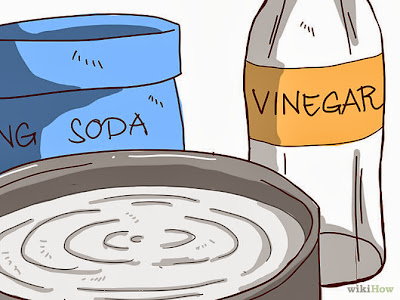Homemade Sodium Acetate Method
Step 1- You will need to add baking soda ( not baking powder) onto a pan.
An Approximate of 6 tablespoons would be good.
Step 2- Now you will be required to add White Vinegar onto the baking soda until it stops fizzing.
An estimate of 2 liters of vinegar should do the job.
 Step 3- Boil the solution till about an approximate of 90 percent of the water solution has evaporated.
Step 3- Boil the solution till about an approximate of 90 percent of the water solution has evaporated.
The solution will be ready when you will be able to notice the formation of a crusty film on top of the water solution.
The solution will appear as slight yellow or brown. This indicates that the solution is a more concentrated solution of sodium acetate trihydrate.
Step 4- As the solution finishes boiling down you will be able to notice sodium acetate crystals left sticking onto the bottom of the pan. Pour the solution into a beaker carefully and you must not pour the crystals into the beaker.
Use a spoon to collect the crystals as you will be needing the crystals for later on in the experiment. Do not let the film on the top of your solution get developed or thickened as this indicates that another reaction is occurring stating that your experiment is ruined.
Step 5- After you have moved the solution into a beaker (of your choice) add 2 tablespoons of vinegar into the solution.
The solution will not solidify due to the vinegar keeping the solution in its aqueous form.
Step 1- You will need to add baking soda ( not baking powder) onto a pan.
An Approximate of 6 tablespoons would be good.
Step 2- Now you will be required to add White Vinegar onto the baking soda until it stops fizzing.
An estimate of 2 liters of vinegar should do the job.
 Step 3- Boil the solution till about an approximate of 90 percent of the water solution has evaporated.
Step 3- Boil the solution till about an approximate of 90 percent of the water solution has evaporated.The solution will be ready when you will be able to notice the formation of a crusty film on top of the water solution.
The solution will appear as slight yellow or brown. This indicates that the solution is a more concentrated solution of sodium acetate trihydrate.
Step 4- As the solution finishes boiling down you will be able to notice sodium acetate crystals left sticking onto the bottom of the pan. Pour the solution into a beaker carefully and you must not pour the crystals into the beaker.
Use a spoon to collect the crystals as you will be needing the crystals for later on in the experiment. Do not let the film on the top of your solution get developed or thickened as this indicates that another reaction is occurring stating that your experiment is ruined.
Step 5- After you have moved the solution into a beaker (of your choice) add 2 tablespoons of vinegar into the solution.
The solution will not solidify due to the vinegar keeping the solution in its aqueous form.



No comments:
Post a Comment